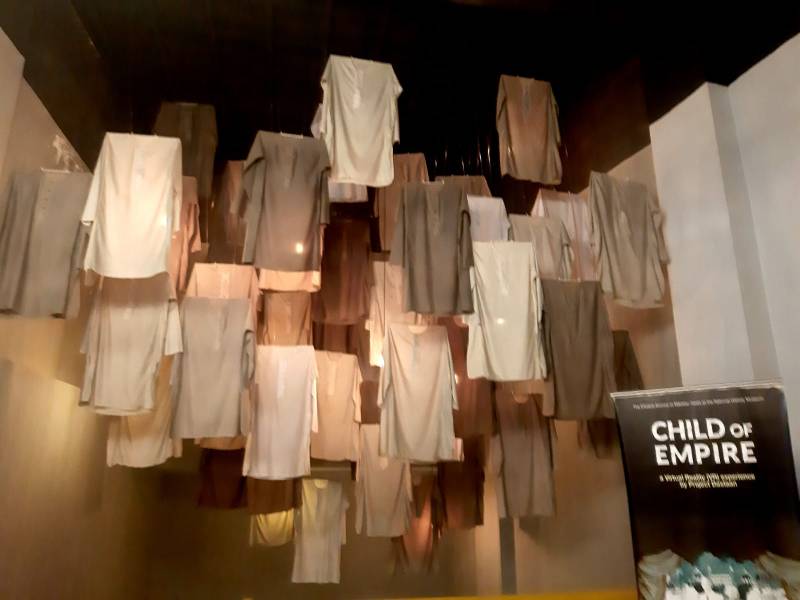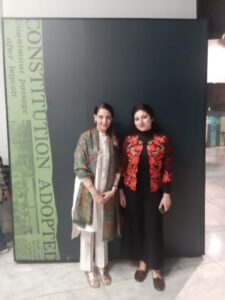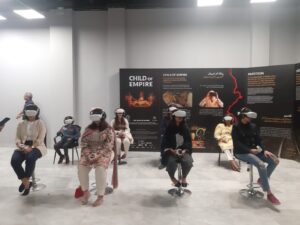
In collaboration with the Citizens Archive of Pakistan(CAP), Project Dastaan held the first screening of their film in Pakistan on November 19 at the National History Museum in Greater Iqbal Park, Lahore. During the screening, co-founder of Project Dastaan Saadia Gardezi and the General Manager of the CAP Noor Ahmed had a Q and A session with an audience. They also shared a special video showing the social impact of Project Dastaan’s work in using virtual reality to help survivors of Partition get access to their ancestral homes on the other side of the border.
 During the session, Noor Ahmed announced that Child of Empire would now be a permanent part of the National History Museum’s exhibition so anyone during open hours could view the film due to the assistance of Project Dastaan.
During the session, Noor Ahmed announced that Child of Empire would now be a permanent part of the National History Museum’s exhibition so anyone during open hours could view the film due to the assistance of Project Dastaan.
‘Child of Empire’ is an animated film of about 20 minutes set in VR made on Occulus Quest. It has been produced by Project Dastaan with the assistance of Anzufilms, thedocsociety, Catchlight.io, British Film Institute, Penguinpop.uk and the British Council.
The film premiered at Sundance 2022 in Park City, Utah in the United States and has also toured in the UK in Oxford and the Derby Museum.
During the session, Saadia explained that the film is about two men from India and Pakistan who play dice and sip tea together as they recount their respective stories during the Partition of India in 1947. This is actually the largest human migration in history. Millions of people crossed the border of Pakistan and India during this time, a large proportion of these migrants died tried to get over the border to reach friends, family and refugee camps.
The two men are Ishaq Das Arora, voiced by Adil Hussain and Iqbal-ud-din Ahmed, voiced by Salman Shahid. These two men are shown as children when they were forced to leave their homes due to the discrimination and the potential violence that they were in danger of being victims to during Partition.
During the session, Saadia shared that the character of Ishaq Das Arora is the maternal grandfather of one of Project Dastaan’s co-founders, Sparsh Ahuja, who migrated to India. On the other hand, the other character Iqbal-ud-din Ahmed, also based on a real person migrated to Pakistan.
Due to the political, religious and ethnic tensions that has been the norm between Pakistan and India in the 75 years since Partition, was not possible for either survivor to visit their childhood and ancestral homes across the highly regulated border.
Hence Project Dastaan decided to help Partition survivors like Mr Iqbal and Mr Arora visit their childhood homes once more by using VR. So far, Project Dastaan have done the same for dozens of Partition survivors.
This eventually gave way to Project Dastaan producing Child of Empire to not only help the older generation reconnect with their past but also teaching young people their history.
Child of Empire was set in VR to provide the most immersive and interactive experience possible to ‘put people in the shoes of the storyteller’. As per Saadia, it provides a better understanding to the viewer about what the Partition survivors went through.

The film animations themselves are high quality and it truly does feel as if one is there in the moment looking through another’s eyes. The colors in the animation are vibrant as well as rugged giving the environment more realism. A VR controller is also given to viewers to interact with objects around them in the VR setting making the experience enjoyable and highly immersive.
Afterwards, Saadia took questions from the audience and and heard the question of whether Project Dastaan or Child of Empire had any anti-Pakistani political agenda to which she answered that Project Dastaan is merely a peace-building initiative and that their aim was to “promote understanding and provide education regarding what Partition survivors on both sides went through and that while both sides may be separated by politics they could still appreciate and understand simple human suffering.”
Furthermore, she said that while Project Dastaan is based in the UK rather than India or Pakistan it is important to educate the rest of the world too as colonialism is a conversation that is avoided in the West, including in their educational syllabus’s.
That, and the fact that the largest human migration in history is so rarely discussed and mentioned on the international stage is what motivated project Dastaan to produce Child of Empire and to keep the Partition survivors’ stories alive.
Saadia Gardezi and Noor Ahmed signed off by saying that they were planning to do similar events in Karachi in a collaboration between CAP and Project Dastaan.
In countries like Pakistan and India where there is so much hate for others, such efforts by the CAP and Project Dastaan are critical in promoting peace and love between human beings and is furthermore a revolutionary step forward in terms of peace and education via technology.
 During the session, Noor Ahmed announced that Child of Empire would now be a permanent part of the National History Museum’s exhibition so anyone during open hours could view the film due to the assistance of Project Dastaan.
During the session, Noor Ahmed announced that Child of Empire would now be a permanent part of the National History Museum’s exhibition so anyone during open hours could view the film due to the assistance of Project Dastaan.‘Child of Empire’ is an animated film of about 20 minutes set in VR made on Occulus Quest. It has been produced by Project Dastaan with the assistance of Anzufilms, thedocsociety, Catchlight.io, British Film Institute, Penguinpop.uk and the British Council.
The film premiered at Sundance 2022 in Park City, Utah in the United States and has also toured in the UK in Oxford and the Derby Museum.
During the session, Saadia explained that the film is about two men from India and Pakistan who play dice and sip tea together as they recount their respective stories during the Partition of India in 1947. This is actually the largest human migration in history. Millions of people crossed the border of Pakistan and India during this time, a large proportion of these migrants died tried to get over the border to reach friends, family and refugee camps.
The two men are Ishaq Das Arora, voiced by Adil Hussain and Iqbal-ud-din Ahmed, voiced by Salman Shahid. These two men are shown as children when they were forced to leave their homes due to the discrimination and the potential violence that they were in danger of being victims to during Partition.
During the session, Saadia shared that the character of Ishaq Das Arora is the maternal grandfather of one of Project Dastaan’s co-founders, Sparsh Ahuja, who migrated to India. On the other hand, the other character Iqbal-ud-din Ahmed, also based on a real person migrated to Pakistan.
Due to the political, religious and ethnic tensions that has been the norm between Pakistan and India in the 75 years since Partition, was not possible for either survivor to visit their childhood and ancestral homes across the highly regulated border.
Hence Project Dastaan decided to help Partition survivors like Mr Iqbal and Mr Arora visit their childhood homes once more by using VR. So far, Project Dastaan have done the same for dozens of Partition survivors.
This eventually gave way to Project Dastaan producing Child of Empire to not only help the older generation reconnect with their past but also teaching young people their history.
Child of Empire was set in VR to provide the most immersive and interactive experience possible to ‘put people in the shoes of the storyteller’. As per Saadia, it provides a better understanding to the viewer about what the Partition survivors went through.

The film animations themselves are high quality and it truly does feel as if one is there in the moment looking through another’s eyes. The colors in the animation are vibrant as well as rugged giving the environment more realism. A VR controller is also given to viewers to interact with objects around them in the VR setting making the experience enjoyable and highly immersive.
Afterwards, Saadia took questions from the audience and and heard the question of whether Project Dastaan or Child of Empire had any anti-Pakistani political agenda to which she answered that Project Dastaan is merely a peace-building initiative and that their aim was to “promote understanding and provide education regarding what Partition survivors on both sides went through and that while both sides may be separated by politics they could still appreciate and understand simple human suffering.”
Furthermore, she said that while Project Dastaan is based in the UK rather than India or Pakistan it is important to educate the rest of the world too as colonialism is a conversation that is avoided in the West, including in their educational syllabus’s.
That, and the fact that the largest human migration in history is so rarely discussed and mentioned on the international stage is what motivated project Dastaan to produce Child of Empire and to keep the Partition survivors’ stories alive.
Saadia Gardezi and Noor Ahmed signed off by saying that they were planning to do similar events in Karachi in a collaboration between CAP and Project Dastaan.
In countries like Pakistan and India where there is so much hate for others, such efforts by the CAP and Project Dastaan are critical in promoting peace and love between human beings and is furthermore a revolutionary step forward in terms of peace and education via technology.

